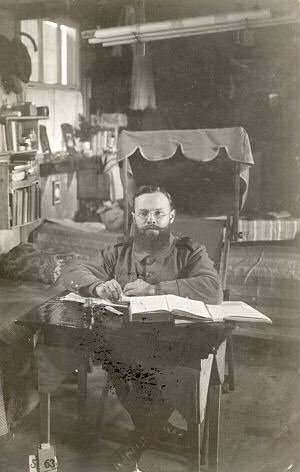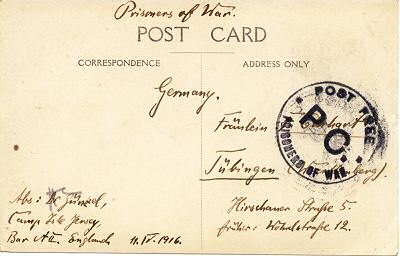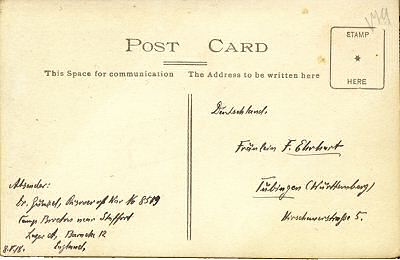| Dr
Günzel was fortunate to have survived what the British call the First Battle
of Ypres since German casualties were particularly heavy, and which was regarded
in Germany as "Kindermord bei Ypern" - "The Massacre of the Innocents
at Ypres". But, it is interesting to note that on all three postcards, he
referred to himself as Dr. At the present time we do not know his rank, but
from Fräu Günzel's memoirs, her reference to "brief training"
may suggest that he was a private soldier. The prisoner on the right in Postcard
1 wearing the white uniform was probably a Naval Petty Officer, while a close
examination of Postcard 2 reveals the number "242" on Dr Günzel's
epaulettes which undoubtedly indicated that he had served with the 242nd Reserve
Infantry Regiment before being taken prisoner. The 242nd Regiment was part of
the 54th (Württemberger) Reserve Division and it would have 200 men taken
prisoner by the British 7th Division on 24th October, 1914. Dr Günzel was
probably one of these 200.
|

Dr
Günzel in Jersey (card 2) Sharp-eyed readers will
notice something curious about Postcard 2, since there are books or objects with
the numbers 5 and 63 at the bottom left of the photograph. Was this some form
of coded message that was being communicated back to Germany? Was it something
more mundane, such as the number of days since Dr Günzel had been captured
although this is inconsistent with the probable date? Or, was it simply a reference
for the photographer? | 
On
the back of postcard 2 is written: Prisoners of War, Germany. Fräulein
F. Ehrhart,
Tübingen (Württemberg)
Hirschauer Straße 5.
früher (formerly) Wöhrdstraße 12. Abs[ender]: Dr Günzel,
Camp Isle Jersey
(Bar[acke] A II) England.
11.IV.1916
|

The
third postcard was sent from Brocton and on its back is written: Deutschland
Fräulein
F. Ehrhart,
Tübingen (Württemberg)
Hirschauer Straße 5.
Absender: Dr Günzel,
Prisoner of War No 8579,
Camp
Brocton near Stafford
Lager A, Baracke 12, England.
8.V.1918 As
Major Naish had highlighted in his account to the Société Jersiaise
in 1920, prisoners were returned to mainland England to carry out work on the
farms since, for a variety of reasons, the Jersey farmers had been unwilling for
prisoners to assist. In conclusion, we are delighted that we are able to
include these pictures even though they give a very small indication of the conditions
inside the buildings. We hope that more can be found.
| |